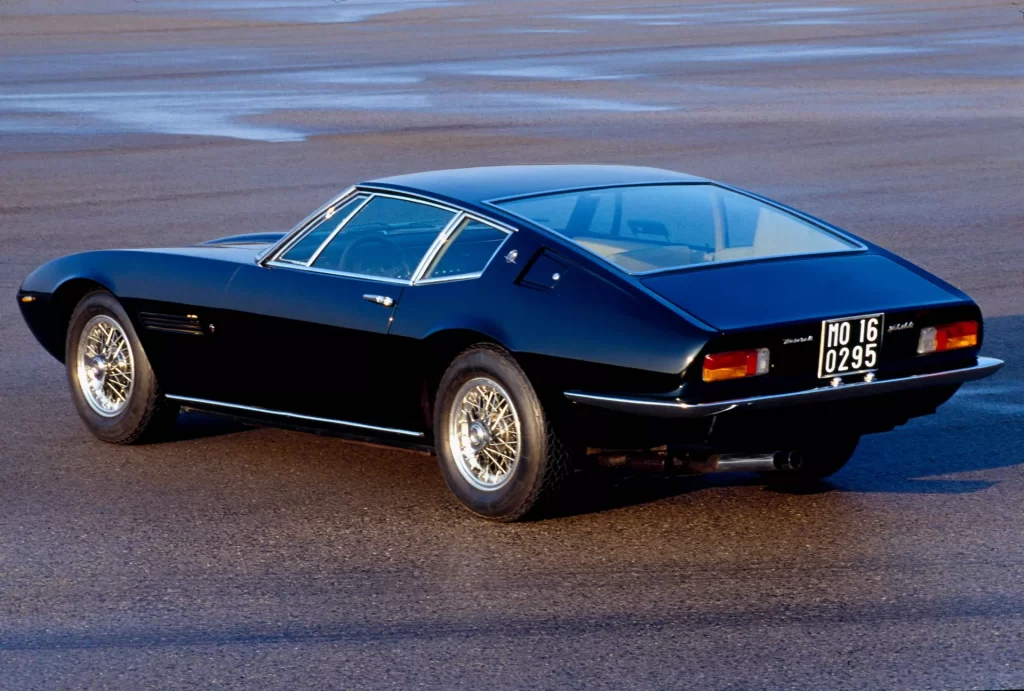Adam Levine sues over “fake” 1971 Maserati Ghibli SS 4.9 Spyder

Maroon 5 frontman Adam Levine is seeing red over being sold what he claims is a fake Maserati. According to multiple media outlets, Levine is suing Houston classic car dealer Rick Cole, alleging that Cole or his agents altered documentation and chassis and engine authentication markings on what was presented as a rare 1971 Maserati Ghibli 4.9 Liter SS Spyder.
The Los Angeles Times, New York Post, and Robb Report were among the news organizations reporting that the Adam Levine Living Trust filed suit in California on February 17 to undo the $950,000 deal. According to court documents, in 2020 Levine traded two Ferraris and cash to classic car dealer Rick Cole for the 4.9-liter Ghibli SS Spyder, which Levine believed was one of only 25 models built.
Levine alleges that Cole—whose website describes him as an “internationally recognized sales agent, auctioneer, and appraiser of investment grade automobiles” with 50 years of experience—was “well aware” the Ghibli 4.9 Liter SS Spyder was not authentic when he made the deal. The lawsuit accuses Cole of negligent misrepresentation, intentional misrepresentation, fraudulent concealment, and breach of contract.
Cole has not responded to a request for comment.

The Maserati Ghibli, an Italian gran turismo (grand tourer) with a long, sleek Giugiaro-styled steel body and aggressive posture, debuted at the Turin Motor Show in 1966 to much fanfare. Produced from 1967–73, Ghiblis share their underpinnings and mechanicals with the Mexico 2+2 coupe and Quattroporte sedan, and most came with a twin-cam 4.7-liter V-8.

Only 125 received the more-powerful 4.9-liter V-8, including 25 SS Spyders, such as the 1972 model above. With 335 horsepower and a 168-mph top speed to match its stunning looks, the SS was one of the most desirable sports cars in the world. It was also one of the most expensive at the time, costing about $21,000 ($155,125 today).
Maserati Ghibli 4.9 Liter SS Spyders rarely change hands, either privately or via public auction, but VIN 1237 sold for $1.5 million at Gooding & Company’s 2016 Pebble Beach auction.
According to Levine’s lawsuit, a representative of his Trust drove “an authentic Maserati Ghibli 4.9 Liter Spyder with a clear and indisputable identity” in Monterey in 2019, and a year later Cole alerted Levine that he had found an authentic Ghibli 4.9 Liter Spyder that he said was “as good” as the other one. In December 2020, the Levine Trust agreed to trade a 1972 Ferrari 365 GTC/4, a 1968 Ferrari 365 GTC, and $100,000 for the ’71 SS Spyder.
View this post on Instagram
The lawsuit claims that Cole represented the Ghibli as VIN AM115.492.1241, but that car was actually sold several years ago to British luxury car collector Clive Joy and “has been in Switzerland ever since as part of Clive Joy’s collection.” In addition, the lawsuit alleges that numbers stamped on the chassis and engine in the Levine car do not match the original fonts and styles.
The authenticity of the Levine Ghibli was disputed as far back as 2015, the suit claims, when it was pulled from an auction.

“After the questioning of the authenticity of the vehicle [at the auction], someone tried to make the vehicle appear authentic by reproducing or stamping a new chassis plate to make the writing seem more like that used by Maserati at the time, in an obvious attempt to convince a potential buyer,” the lawsuit alleges. “Upon information and belief, it was Cole and/or his agents who made these changes.”
The suit also claims that Cole attempted to authenticate the car by showing documentation signed by Maserati expert Fabio Collina, but that document was for the “real” 1241, not the car that Levine purchased. The suit acknowledges that the car may be an original Ghibli Spyder with a swapped engine or perhaps a converted coupe, “but either way, the vehicle is not authentic, has no identity and/or has a very questionable identity, which seriously undermines its value.”
***
Check out the Hagerty Media homepage so you don’t miss a single story, or better yet, bookmark it. To get our best stories delivered right to your inbox, subscribe to our newsletters.




The question of fakes has always been an interesting one in my mind… moreso with art than with cars. If you can produce a painting that is so close to the work of the original masters that it takes an electron microscope and a chemistry set to tell it apart, than you have successfully recreated something that has all of the aesthetic appeal of the original… why logically would it be worth significantly less?
I have a 454 corvette that carries the VIN code of a 350. You know what? I don’t care. The driving experience is what I wanted, and the folks who see the car when I am out and about don’t care either. Of course I knew all of this when I bought the car, which is an important distinction
The issue boils down to exclusivity. It is that it is rare and unapproachable for the average person. Not to say that falsifying an original isn’t wrong, but someone who is hung up on the font on the VIN plate probably doesn’t really care about the driving experience, curb appeal, etc.
1 – Worth less logically because it is a reproduction; i.e. not original.
2 – You knew … quite the vital distinction.
3 – Hung up on the font? Maybe hung up on receiving what you paid for.
In reality if someone sold me a fake anything (without disclosure) I’d be suing too.
This is more of a philosophical discussion on why two items that are nearly identical in almost every tangible detail and require significant investigation to differentiate would have dramatically different values
Here’s a wonderful sirloin steak, ignore the McDonald’s bag that it is in.
If it’s hitting all of the umami marks, I’m a happy customer
I disagree. Someone who wants the car they paid for and cares about the authenticity of the car is someone who care more, than someone who is looking for a fake “driving experience”
It’s about provenance which means little to you and me but to collectors, like it or not, is EVERYTHING.
It’s a shame this happens but money makes people do some shady things. While I have seen this problem on early classics like Porsche & Ferrari is it much more prevalent on muscle cars. A rebodied Charger or Chevelle, with the tags from a highly optioned but wrecked model, is common place. Some of these are great fakes that fool most buyers.
Does anybody besides me think that black coupe in the picture looks like a Z-car? Maybe the whole lineup are fake? 😉
I thought it had some styling similarities to a C3
I can see that – especially in the front shot of the white convertible. Those upright bumperettes are C3-like for sure!
I hope Adam Levine gets twice his money back in court and gets to keep the fake into the bargin .
Great example of not taking the buyer at his word. Always bring in another expert. Looks like Adam didn’t do his due diligence.
Obviously a fraud. Buddy should do jail timeb
I have bought, sold, and traded for years.
Ultimately it’s the buyer or buyer’s agent which needs to sign off on authenticity, regardless of the value. Once the bill is paid and title trades hands the transaction is done.
I think the phrase is Due Diligence…
As a dealer I disagree. Fraud is fraud. If the seller states that its authentic, its on the seller. Any court in the land will back the buyer as it well should. We had a C2 vette that won all sorts of awards that had a restamped block and disclosed it as such by a world class restoration shop . The last time I saw it sold at auction there was no such mention. Does that absolve the seller? I think not. Pre 81 short VIN cars are very hard to research but a lot of times a quick search of the VIN in google will turn up interesting facts. While its easy to blame the buyer, on a milllion dollar sale the seller should have had his story correct.
If you knowingly change the vin numbers you are doing so for no other reason than to fraudulently increase its value in the marketplace. This is criminal period.